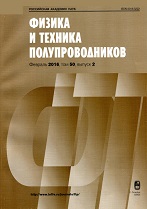|
Эта публикация цитируется в 1 научной статье (всего в 1 статье)
Поверхность, границы раздела, тонкие пленки
Production and identification of highly photoconductive CdSe-based hybrid organic-inorganic multi-layer materials
M. Yfanti-Katti, F. Prokopos-Chouliaras, K. Milonakou-Koufoudaki, C. Mitzithra, K. Kordatos, S. Hamilakis, C. Kollia, Z. Loizos
School of Chemical Engineering, National Technical University of Athens, Greece
Аннотация:
Highly photoconductive thin multi-layers of new hybrid organic-inorganic semiconductors have been developed. They result by the combination of an inorganic semiconductor with ferrocene, a commercially available compound, applying the electrodeposition and spin coating techniques, introducing sodium oxalate as an additive in the electrolytic bath. The organic layer of the hybrid system is enveloped between two inorganic layers in a sandwich-like structure. The full characterization of the final products by XRD, SEM-EDAX, band gap and photoelectrochemical cell (PEC) measurements confirmed the development of the hybrid semiconducting system. The outer electrodeposited CdSe layer of the sandwich-like materials exhibits a definite hexagonal structure, whereas, as derived from the XRD and band gap data, the development of a new semiconducting compound has been confirmed. Thus, due to a synergic action, the three-layer materials present a remarkably improved photoresponse compared to that of the pure cubic CdSe electrodeposited in the presence of the oxalate additive as well as the three-layer hybrid CdSe-based products developed in our previous work in additive-free electrolytic baths.
Поступила в редакцию: 11.08.2016
Исправленный вариант: 07.02.2017
Образец цитирования:
M. Yfanti-Katti, F. Prokopos-Chouliaras, K. Milonakou-Koufoudaki, C. Mitzithra, K. Kordatos, S. Hamilakis, C. Kollia, Z. Loizos, “Production and identification of highly photoconductive CdSe-based hybrid organic-inorganic multi-layer materials”, Физика и техника полупроводников, 51:12 (2017), 1651–1655; Semiconductors, 51:12 (2017), 1592–1596
Образцы ссылок на эту страницу:
https://www.mathnet.ru/rus/phts5969 https://www.mathnet.ru/rus/phts/v51/i12/p1651
|


| Статистика просмотров: |
| Страница аннотации: | 23 | | PDF полного текста: | 5 |
|





 Обратная связь:
Обратная связь: Пользовательское соглашение
Пользовательское соглашение
 Регистрация посетителей портала
Регистрация посетителей портала Логотипы
Логотипы








 Цитирование в формате
Цитирование в формате 
